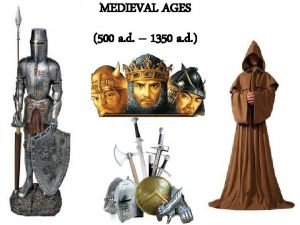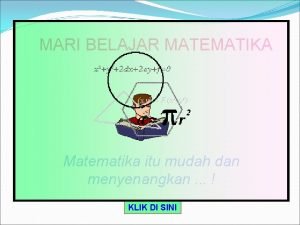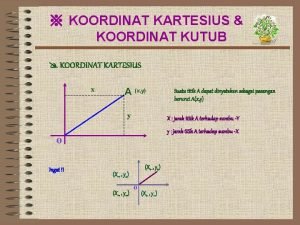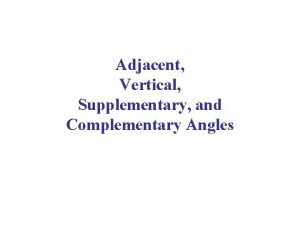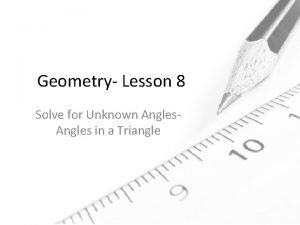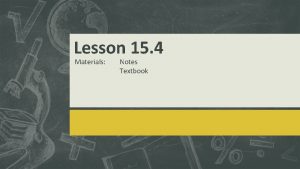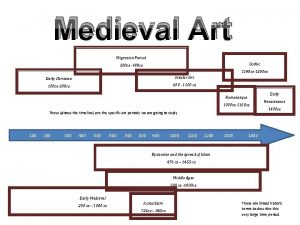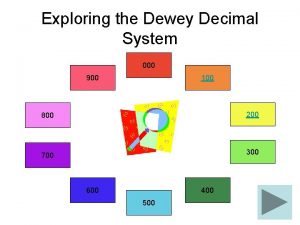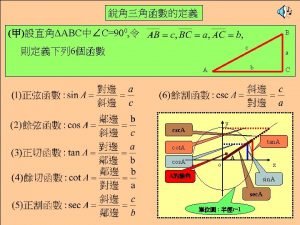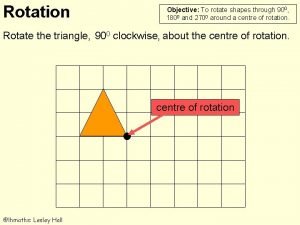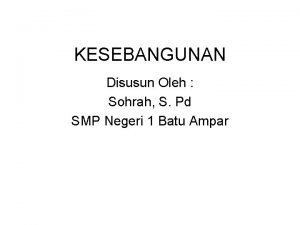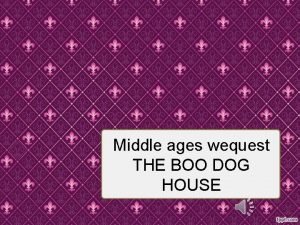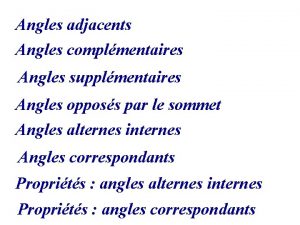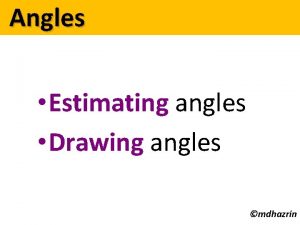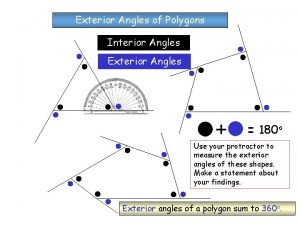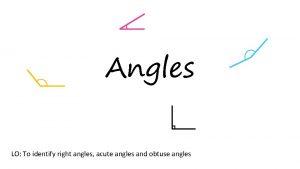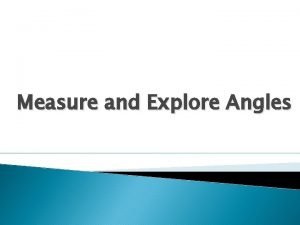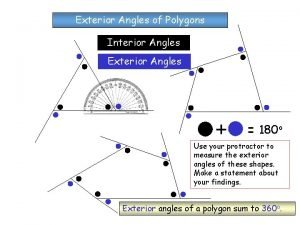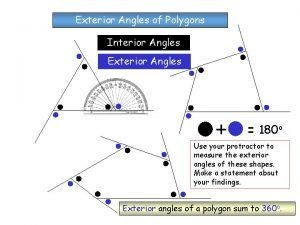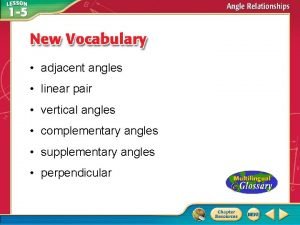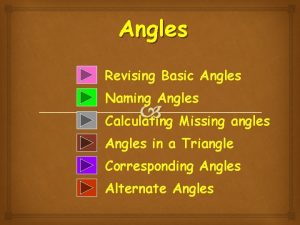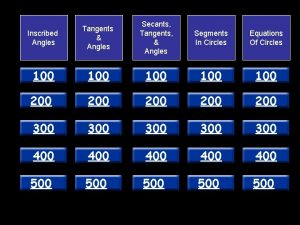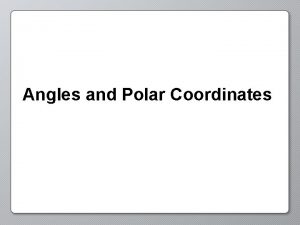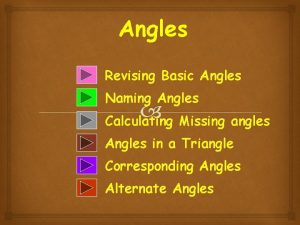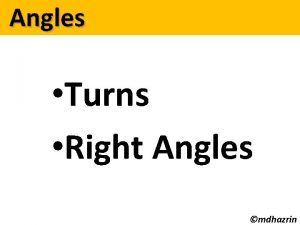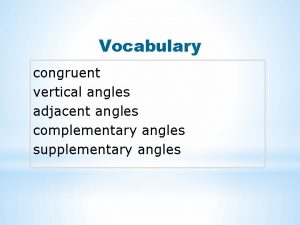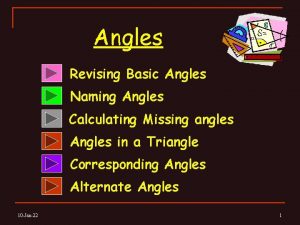INTRODUCTION TO ANGLES 450 900 1350 STEM Prep




















































- Slides: 52

INTRODUCTION TO ANGLES 450 900 1350 STEM Prep Project, Unlimited Learning, Inc

Please use your mouse to click through each slide. That will allow animations and quizzes to play correctly. Use the back arrow key on your keyboard or the back arrow icon at the bottom left part of each slide to move to previous slides. Move your cursor here to use back arrow

ANGLES… WHY CARE? While we may not realize it, angles are all around us… When we are driving up or down a hill, the road is at an angle, and that affects how much fuel we use. Every building we see is built using different angles that provide different levels of strength. The distance a baseball goes partly depends on the angles you use during the swing. https: //commons. wikimedia. org/wiki/File: Chase_Utley_Home_Run. jpg And of course as you learned in the lab, our own movement depends on the angles we can make with our bodies. https: //commons. wikimedia. org/wiki/File: Shunsuke 1_20080622. jpg

In this section, we will practice math skills related to geometry. You will learn about lines, rays, segments, angles and shapes.

GEOMETRY Geometry is a math category that deals with relationships between points, lines, surfaces, solids, and other dimensions. In other words, geometry is about lines and shapes. The term, geometry, comes from Greek. “Geo-” means “earth, ” -metry comes from “measurement. ” You might say that geometry studies measurements among earth’s objects.

ANGLES An angle measures the space between two intersecting lines or rays. In order to have an angle, two lines must intersect. They must meet at some point. That point between two intersecting lines forms an angle. Think about a road intersection. (Click to see animation. ) This is an angle

1. RAYS A ray is an essential term when working with angles. Think of the sun. Sun rays start at the sun and go forever. Imagine a line that starts at any point in your imagination and keeps going forever. That kind of line is called a RAY. The starting point on a ray is actually called “the end point. ” The sun would be called the end point for its rays. Of course, that doesn’t make much sense, does it? It should be the starting point, but it isn’t! The point at which you see the start of a ray is called the End Point!

Let’s label the end point on a ray as A. A End Point Now imagine that the ray continues, and you set additional points along that ray. You might label those as B, C, and so forth. It would look like the ray in the image below. (Click to see the image. ) A End Point B C To find out more about rays, go to. . http: //www. mathopenref. com/ray. html

2. LINES What is the difference between a line and a ray? Well a RAY has a beginning point called an “end point, ” right? Then a ray keeps going in one direction forever. In math, a LINE has no defined beginning or end point. Imagine that it just keeps going forever in both directions. Line Ray

How do rays and lines relate to angles? Remember the definition of an angle: an angle measures the space between two intersecting lines or rays at or close to the point where they meet. (Click to see the animation. ) These are lines that are intersecting each other.

DRAWING LINES AND LABELING POINTS On your answer sheet, draw a long horizontal ray (a line with a “end point” that then goes forever. Now draw a line ( ) going across that ray, and have it intersect the first ray you drew. Label that intersection as “A. ” Repeat the process using a line going in a different direction and intersecting the first ray at a different point. Label that intersecting point as “B. ” Continue the process drawing more lines, intersecting your first ray as before until you have points “C, ” “D, ” “E, ” and “F. ” See sample images below of intersecting points. A B C D E F

Look at the two moving lines below. Will they intersect at some point? Click to see. Yes! Now look at the two lines below. Will they ever intersect? Click to see. If you said, “No, ” you would be right. Lines that run next to each other and never intersect are called parallel lines. This means that parallel lines can not form angles.

3. SEGMENTS Another important term in geometry is SEGMENT. You will often be working with segments to measure angles. A segment in geometry represents the distance between points on a ray. The image below shows two segments along the ray. A C B End Point The segments are referred to as AB and BC. When you name a segment on a ray, you will often see a line over the top to show it is a segment. AB BC Sometimes, you will find that each segment is identified by a lowercase letter instead. In the image below, the segments are named q and z instead of AB and BC. A End Point q B z C

Decide True (T) or False (F) and write your answers on your answer sheet. When you are done, click for answers. . T F 1. This is a line 2. This is a ray. 3. These lines will intersect. 4. These lines form only three angles. 5. The yellow segment is called AB 6. “Geo-” comes from Latin. 7. “-metry” means graphing. 8. The start of a ray is called and end point. 9. This road intersection sign forms four angles. T F T F A B C T F T F

Correct your answers on your answer sheet. 1. This is a line 2. This is a ray. 3. . T F T F These lines will intersect. 4. These lines form only three angles. 5. The yellow segment is called AB 6. “Geo” comes from Latin. 7. “Metry” means graphing. 8. The start of a ray is called and end point. 9. This road intersection forms four angles. T F A B No. They are parallel. No. They form 4 angles. T F C No. It comes from Greek. No. It means measurement. T F No. It forms two angles. No. It is BC.

Now let’s talk more about angles. Remember, an angle measures the space between two intersecting lines/rays at or close to the point where they meet. The point where the two lines or rays intersect to form an angle is called the vertex. The angle between the intersecting rays or lines is shown by drawing part of a circle between them. Usually, that curved line is small and close to the intersecting point. The point of intersection is called the vertex. This curved line represents the angle.

How many angles are formed in this image of a polyhedron? Write your answer on your answer sheet.

Angles are represented by curved lines that join the space between the two intersecting lines. Copy the following angles on your answer sheet and draw curved lines to represent the space of the angles.

4. MEASURING ANGLES You know how to measure lengths and distances in the United States with units like inches, feet, yards, and miles. Most other countries measure distances in units like meters and kilometers. You know how to measure weights in the United States in units like pounds and tons. Most other countries measure weights in kilograms. Angles are measured in the same way all over the world, thankfully! We measure angles using degrees in the same way that we use degrees to measure temperatures, but they mean different things.

Remember, you will find angles represented by a little curve: But why do we show angles in relation to part of a circle?

Here’s the secret. Click to find out! A full circle has 360 degrees, or 3600

A circle has 360 degrees (360 0). Temperature is also measured in degrees. What do circles have to do with temperature? My body temperature is usually between 97. 5 and 97. 9 degrees. That isn’t even close to 3600! As you can see, circles and body temperature are not related. They both use the same term, “degree, ” but don’t get them confused.

When you are dealing with angles, you are measuring how close or how far the lines are within a circle. Two flat lines that meet and form one flat line is a 180 degree angle on circle. 1800

Now that you know that a full circle has 3600, you can figure out how many degrees are in parts of circles! Like you just saw, half (1/2) a circle is 1800 (which is 360 divided by 2). 1800 How many degrees are in a quarter (1/4) of a circle? You just need to find a fourth of 360! 360 ÷ 4 = 90, or 900. Similarly, one eigth (1/8) of a circle would be 360 ÷ 8 = 45, or 450.

So all angles are different degrees that represent a part of a circle. But the top and the bottom of a circle is the same, right? That’s why most times angles are measured using only half a circle (1800).

Now we know that if we draw and angle that represents ¼ of a circle, it will measure 900 If you add 450 to that, you will have 90 + 45 = 1350 If you draw an angle that is only half of 900, you’ll have a 450 angle. 450

900 450 00 1350

In order to talk more easily about angles, let’s give a few of them names. An angle that forms a perfect corner of a square is called a RIGHT ANGLE. That’s why you will often see right angles shown with a square instead of a curve or ¼ circle. 900 PSSST! Here’s a new term – two lines that form a 90° angle are said to be perpendicular (This is basically the opposite of parallel, when they didn’t cross at all!) Right angles are always right. They are never wrong!

An ACUTE ANGLE is an angle that is smaller than 900. 450 Angles between these two blue lines are considered acute. Do you think they are cute?

An OBTUSE ANGLE is an angle that is greater than 900. 1350

Now test your knowledge! Click on the right angle. NOTE: Click only in the box with the angle, NOT outside.

Sorry. That was not the correct choice. Try again!

Good Job!

Click on any obtuse angle.

Sorry. That was not the correct choice. Try again!

Good Job!

Click on any acute angle.

Sorry. That was not the correct choice. Try again!

Good Job!

Click on the link below to go to the following site and play with the tools you see as you scroll down the page. When you are don, return here for more learning! http: //www. mathsisfun. com/angles. html

Now you are ready to measure angles. It is easy to see if an angle is a zero degree (0°), 90 degree (90°) or 180 degree (180°) angle. 00 900 1800 But all angles in between those are impossible to measure exactly just by looking at them. In fact, on an exam, never assume you know how many degrees are in an angle. Always solve problems using the number of degrees that they state on the test. Eyes are deceiving sometimes. You need a tool!

5. PROTRACTORS A protractor is a tool that measures the degree of any angle… usually on paper. Go to the next slide to watch a video on how to use a protractor to measure angles. Allow a few seconds for the video to load.

http: //www. youtube. com/watch? v=t 4 x. COUNEIn. I Allow a few seconds for the video to load.

6. FOUR SIDED SHAPES A rectangle is any shape with four sides where all corners are made up of right angles. 90° 90° A square is a very special shape in geometry. It’s basically a rectangle with four equal sides. What do the angles in a rectangle or square add up to? 90 + 90 = 360! That’s right, the total degrees in a square or rectangle is the same as in a circle! The same is true for a shape called a parallelogram, which is like a tilted rectangle. The angles aren’t 90 degrees, but they still add up to 360: 70° 110°

7. TRIANGLES The images we used to show angles before only had two intersecting rays or lines in each image. These formed only one angle and had only one vertex. What happens when you draw an additional line to intercept both of those rays? How many angles are formed? (Click to see) Three, right? “TRI” comes from both Greek and Latin, meaning three. So the word “tri-angle” simply means a form that has three angles. You probably know other words that use “tri” as a prefix (word beginning) like tripod (3 legged), or triathlon (3 -part competition).

Whether you are working with obtuse, straight, or right triangles, it is helpful to remember that all triangles measure a total of 1800. That’s right, if you add the angles in a triangle it will always equal 180! Check out this website to see this in action: https: //www. mathsisfun. com/proof 180 deg. html 450 600 400 800 600 300 700 1200 450 But why is this true? An easy way to think about it is to remember that a triangle is actually half of a square, rectangle, or parallelogram. So if there are 360 degrees in all of these four sided shapes, there should be 180 degrees in a triangle: 900

To get started measuring different aspects represented in triangles, let’s label a few parts. Earlier in this unit you learned that segments can be identified with labels. We use letters in caps to label a segment by its end points. A End Point AB B BC C We often use small-case letters to identify the segment itself. A End Point q Let’s label a triangle that way. B z C

B e A f HEIGHT d C The triangle above has 3 intersecting points: A, B, and C. It has three sides, or segments: d, e, and f. You will often find those sides represented with lines drawn over the two end points. For example: Side d goes from A to B, and can also be called AB Side e goes from B to C, and can also be called BC Side f goes from A to C, and can also be called CD

Let’s work with the sides of the following triangle. A cm 3 1 d e f 11 cm 8 cm The measurements here are shown in centimeters (cm). You will learn more about metric measurements later. One centimeter is a little smaller than one inch (in). On a test, you might see “in. ” or “cm. ” B a C 1. A perimeter is the sum of the sides of an object. What is the perimeter of this triangle? ______ 2. What is the sum of d and f ? _____ 3. What is the measurement of AB? _____ 4. What is the measurement of angle “a”? _____ Write your answers on your answer sheet, then click to check your answers.

Correct your answers on your answer sheet. B e A f 11 cm 8 cm cm 13 d a C 1. A perimeter is the sum of the sides of an object. What is the perimeter of this triangle? 13 + 11 + 8 = 32 cm 2. What is the sum of d and f ? 13 + 11 = 24 cm 3. What is the measurement of AB? 13 cm 4. What is the measurement of angle “a”? 900 – It is a right angle.

Review and Practice Turn in your first answer sheet to your coach. Then complete the following worksheets and turn them into your instructor (you should have a print out of them): Angles Basics Using the Protractor Label Parts of Angles Use the symbol to identify or label angles. To label segments or sides of angles, use a straight line above the letters, as you practiced earlier: AB DF Once you complete each worksheet, ask you instructor for the answer sheet and correct your work. Don’t worry, you’ll only be graded for completion on this part. Finally, click here to review some flash cards with all of the terms you learned in this lesson (you can also play games with the terms!): https: //quizlet. com/87775546/math-module-21 -introduction-to-angles-flash-cards/

CONGRATULATIONS! You now have a good introduction to basic geometry and angles! Ready to take the quiz?
 36 nın yüzde 40 ı
36 nın yüzde 40 ı Gambar trigonometri
Gambar trigonometri Opposite angles
Opposite angles 1350 ad
1350 ad Kaki sudut adalah
Kaki sudut adalah Lol 450 champions
Lol 450 champions Sudtradhara
Sudtradhara How long ago was the renaissance
How long ago was the renaissance It had long since come to my attention
It had long since come to my attention Hitunglah besar sudut poq
Hitunglah besar sudut poq Koordint cartesius titik a(4, 600) adalah....
Koordint cartesius titik a(4, 600) adalah.... Are complementary angles adjacent
Are complementary angles adjacent Find the unknown labeled angles
Find the unknown labeled angles Intersecting chords
Intersecting chords Gv black's classification
Gv black's classification 49 900
49 900 Account title
Account title Dewey 900
Dewey 900 Power xpert 900
Power xpert 900 Simão aplicou 500
Simão aplicou 500 Ge mds transnet 900 radio
Ge mds transnet 900 radio Il teatro barocco
Il teatro barocco Cubismo caratteri generali
Cubismo caratteri generali Rzymskie cyfry zero
Rzymskie cyfry zero Harper industries has $900 million of common equity
Harper industries has $900 million of common equity Nhập khẩu 900 lít rượu 42
Nhập khẩu 900 lít rượu 42 Hked city
Hked city How many significant figures in 900
How many significant figures in 900 Ul 900 testing
Ul 900 testing Istituto comprensivo 7 imola
Istituto comprensivo 7 imola 900 east washington street
900 east washington street Lra-900
Lra-900 900 m/s
900 m/s Insular art is art produced between 300 and 900 ce
Insular art is art produced between 300 and 900 ce Letteratura spagnola del 900
Letteratura spagnola del 900 Dewey decimal 100
Dewey decimal 100 649 en yakın yüzlük
649 en yakın yüzlük 100+200+300+400+500+600+700+800+900
100+200+300+400+500+600+700+800+900 Yuvarlanabilecek sayılar
Yuvarlanabilecek sayılar Bud light canopy
Bud light canopy Lexile range chart
Lexile range chart Sin cos tan cot
Sin cos tan cot 900 rotation
900 rotation Diketahui pq // ab rq // ac bac = 65°
Diketahui pq // ab rq // ac bac = 65° Caratteristiche del romanzo del 900
Caratteristiche del romanzo del 900 7 500 000 000 000 000 000 in scientific notation
7 500 000 000 000 000 000 in scientific notation What 23900000 in scientific notation?
What 23900000 in scientific notation? Pcs 900
Pcs 900 Evoluzione del romanzo dall'800 al 900
Evoluzione del romanzo dall'800 al 900 900 игр
900 игр Gcs 900
Gcs 900 Las 900 tesis
Las 900 tesis Around 900 ce a new form of government called
Around 900 ce a new form of government called



